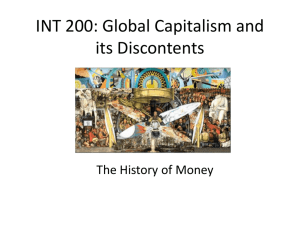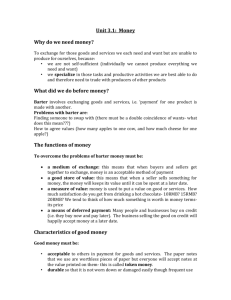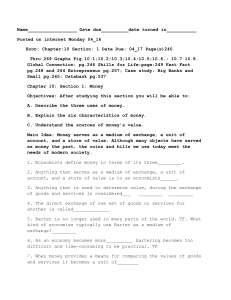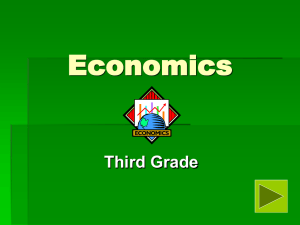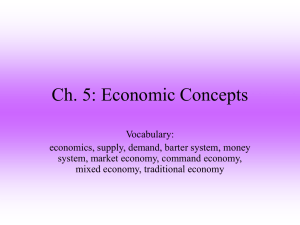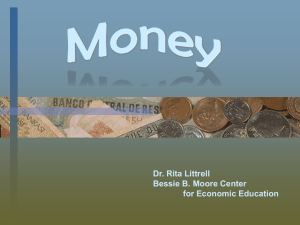MONEY
advertisement
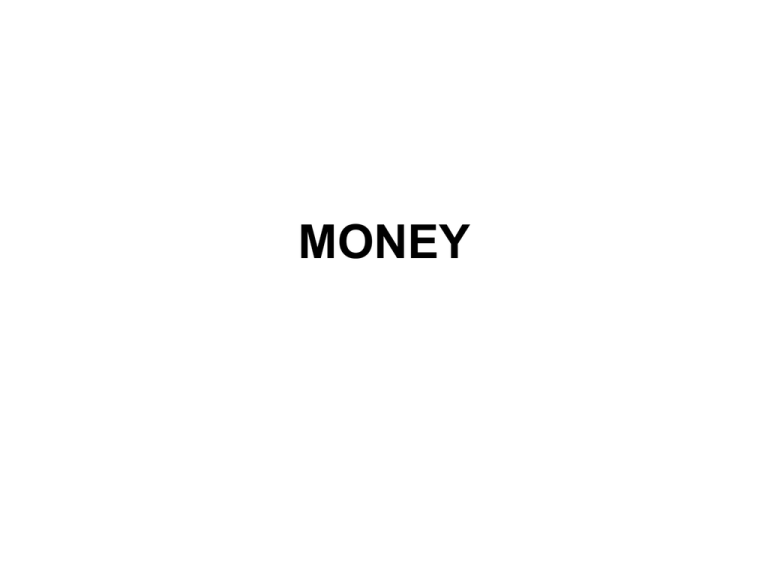
MONEY • One of the important function of a financial system is the monetary function. • This is where the introduction of money into the economy enables those with excess money and those with deficit to separate the act of sale from the act of purchase and allows them to overcome the main problem of barter • Then what is money ? DEFINITION OF MONEY Anything that is generally accepted as a medium of exchange. OR The sets of assets in an economy that people regularly use to buy goods and services from other people. DEVELOPMENT OF MONEY • Barter- In the beginning, people bartered. Barter is the exchange of a good or service for another good or service, a bag of rice for a bag of beans thus it is the direct exchange of goods and services for other goods and services. • Disadvantages of Barter: – Variable Value of Assets – Time-consuming Negotiation of Price – Large number of transactions – Double Coincidence of Wants • The disadvantages of barter provided an impetus for the development of money • To solve that problem humans developed what is called commodity money. • A commodity is a basic item used by almost everyone. • In the past, salt, tea, tobacco, cattle and seeds were commodities and therefore were once used as money. • Commodities were chosen as preferred barter items for a number of reasons – – some because they were conveniently and easily stored, – some because they had high value densities and were easily portable, and – some because they were durable. • These commodities, being widely desired, would be easy to exchange for others and therefore they came to be accepted as money. • Commodities originally accepted for one purpose were often found to be useful for other non-economic purposes • Because of their growing acceptability, they began to be used for general trading supplementing or replacing barter. • However, using commodities as money had other problems. – Carrying bags of salt and other commodities was hard, and commodities were difficult to store or were perishable. COINS MONEY • Metals objects were introduced as money around 5000 B.C. By 700 BC, the Lydians became the first in the Western world to make coins. • Countries were soon minting their own series of coins with specific values. • Metal was used because it was readily available, easy to work with and could be recycled. • Since coins were given a certain value, it became easier to compare the cost of items people wanted • Later paper money was introduced • With the introduction of paper currency and non-precious coinage, commodity money evolved into representative money. • This meant that what money itself was made of no longer had to be very valuable. • In the early days of money, people were very skeptical about accepting an object that only represented value and wasn’t valuable in and of itself. • A willingness to accept something that represents value requires a significant amount of faith, something that early users of money didn’t have. • Representative money was backed by a government or bank's promise to exchange it for a certain amount of silver or gold. • For example, the old British Pound bill or Pound Sterling was once guaranteed to be redeemable for a pound of sterling silver. • For most of the nineteenth and twentieth centuries, the majority of currencies were based on representative money through the use of the gold standard FUNCTIONS OF MONEY • Anything used as money – whether a deerskin, a cowrie seashell, or a dollar bill should fulfill the following functions: • medium of exchange • unit of account • store of value • standard of deferred payment • 1. Medium of exchange: Money permits to trade at less cost in time and effort. • Barter is inefficient because is difficult and time-consuming to find the trading partner. • Barter is the direct exchange of goods and services for other goods and services • A barter system requires a double coincidence of wants for trade to take place. Money eliminates this problem. • As a medium of exchange, or means of payment, money is generally accepted by buyers and sellers as payment for goods and services. • Other benefit: allows specialization (and rises productivity) • 2. Unit of account: Money is the basic unit for measuring economic value • As a unit of account, money is a standard that provides a consistent way of quoting prices. • Given that goods and services are mostly exchanged for money, it is natural to express economic value in terms of money • Caveat: In countries with volatile inflation, money is a poor unit of account because prices must be changed frequently. • More stable units of account used (dollars or gold), even if transactions use local currency. • 3. Store of Value: money is a way of storing wealth. • Other types of assets may pay higher returns, BUT it is a medium of exchange! • As a store of value, money serves as an asset that can be used to transport purchasing power from one time period to another. • Money is easily portable, and easily exchanged for goods at all times. • The liquidity property of money makes money a good medium of exchange as well as a store of value. CHARACTERISTICS OF MONEY Acceptability -- people must be willing to accept it as a means of payment and in settlement of a debt Durability -- must last a reasonable length of time before deteriorating. It should be durable, so that value is not lost by spoilage. • Divisibility -- to function as money an asset must be capable of division into smaller units to accommodate transactions of differing value • The medium of exchange should be divisible because different goods are valued differently • Portability / Convenience -- to function as money an asset must be portable and easy to use, it must be light, small to carry around and easy to transfer ownership • It should be valuable relative to its weight so that amounts large enough to be useful in trade can be easily transported. • Uniformity -- money of the same value must be of uniform quality. • It should be of standardized quality, so that any two units are identical • Stability of Value -- in order to fulfil its various functions (especially as a store of wealth and as a means of evaluating future payment), it must retain its value • Hard for Individuals to Produce Themselves -- it must be hard to forge FORMS OF MONEY Commodity Money – • money that takes the form of a commodity with intrinsic value. • A good used as money that also has value independent of its use as money. . • something that performs the function of money and also has alternative, nonmonetary uses, e.g., gold, silver, cigarettes. • Fiat Money – • money without intrinsic value that is used as money because of government decree. • something that serves as money but has no other important uses, e.g., Coins, currency and checkable deposits (current account) • Money, such as paper currency, that is authorized by a central bank or governmental body and that does not have to be exchanged by the central bank for gold or some other commodity money

